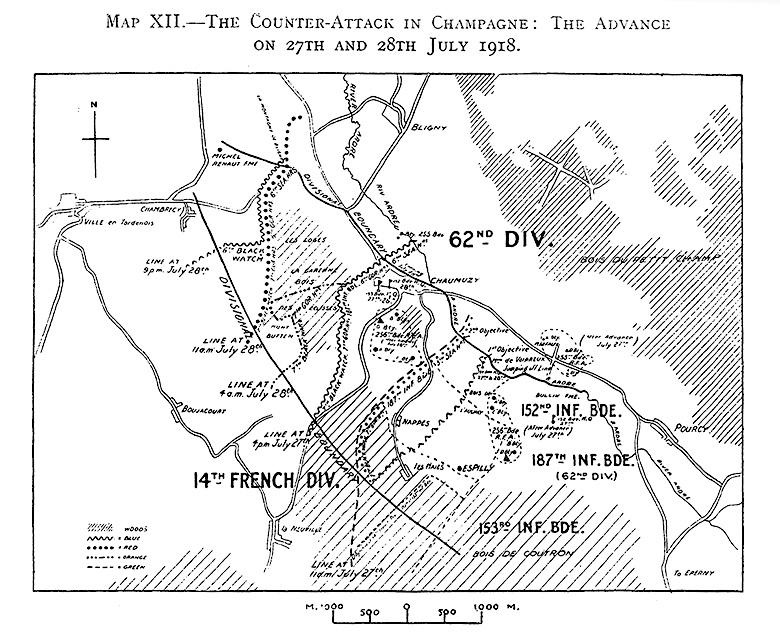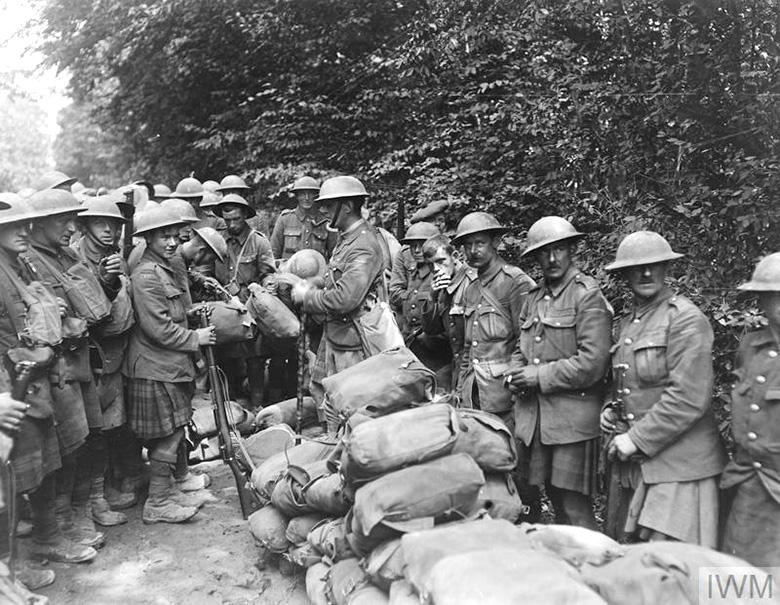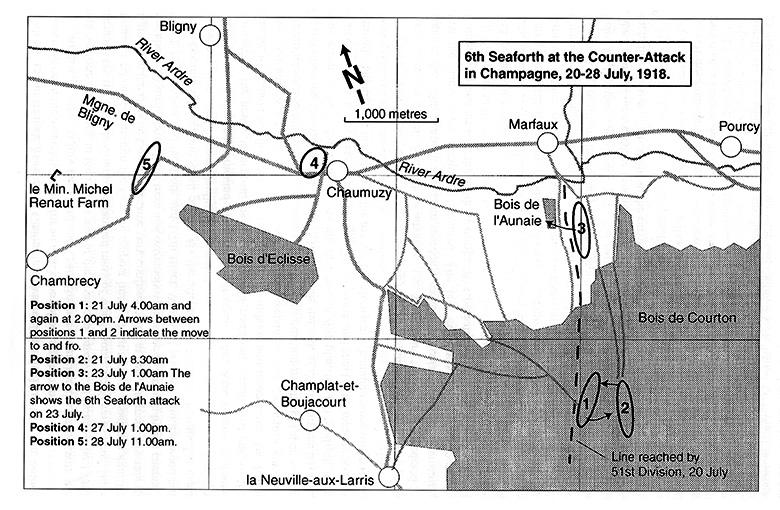The Battles of the Marne
20 - 31 July 2018
On 13th July Marshal Foch requested four British Divisions from Sir Douglas Haig. Haig agreed the 15th, 34th, 51st, and 62nd British Divisions were formed into the XXII nd Corps under the command of Lieut-General Sir A. Godley. The 51st Division moved by train to the new theatre.
On the morning of 14 July, before the first troops had reached their destination the Germans launched an offensive on a front of eighty kilometres east and south-west of Rheims, crossing the Marne, finally being held by the French, American, and Italian forces on this front. This attack was in the first instance checked east and north of Rheims, but as it was making progress westwards along the valley of the Marne towards Epernay and towards the Montagne de Rheims, the divisional destination was changed to Nogent-sur-Seine area from where it moved towards the Marne in the Epernay area. By the night of the 16-17th Divisional headquarters opened at Moussy and by the night of the 17th the 152nd, 153rd, and 154th Brigades established their headquarters at Le Mesnil, Pierry, and Ohouilly respectively and the infantry battalions were almost complete, and the artillery was still awaited.
On 18th July Marshal Foch opened his counter-offensive on the western flank of the Rheims-Soissons salient, which, with a series of counter-attacks delivered south of the Marne, arrested the enemy's advance.

Map Counter-Attack Champagne
show infoDescription:
Sketch map showing the advance during the counter-attack in Champagne over 27th and 28th July 1918.
High Resolution Image:
Tags:
On the 19th the Division was moved, crossing the Marne at Epernay to the Foret de la Montagne de Rheims.
The following are extracts from Bewsher.
The area in which the Division was to operate was on the western edge of the Montagne de Rheims, the great massif which the enemy had endeavoured to seize in order to tum the Rheims defences from the south and to dominate the Marne valley.
The sector allotted to the XXIInd British Corps covered a front of 8000 yards astride the Ardre river, a stream running northwards to the Vesle, and consisting of an open valley bottom with steep wooded slopes on either side. Both valleys and slopes were studded with villages and hamlets, which were for the most part intact, and afforded excellent cover.
The northern boundary of the 51st Division was the river Ardre, which at the point where the attack began was little more than a ditch. The most formidable obstacle in the path of the Division was the dense wood, the Bois de Coutron, which stretched for 3500 yards from the jumping-off line in the direction of the attack. This wood was composed of a thick tangle of trees traversed by rides and country tracks, both laterally and from front to rear. On the slopes of the valley at the edge of this wood lay the hamlets of Espilly, Les Haies, and Nappes, which linked up the defenders in the wood with various points d'appui in the valley.
The valley itself was also admirably suited for concealed defences, consisting as it did of small woods, mills, banks, and sunken roads hidden by standing corn.
During the 19th the course of the fighting had been such that in the instructions received by the Division it was stated that the enemy appeared to be retiring on a wide front covered by rearguards. The orders issued for the attack therefore provided for a deep advance into enemy territory, the final objective selected, the Brown line, being at its greatest distance nine and a half kilometres from the jumping-off line. The first objective, the Blue line, corresponded roughly with the old French front line, and was from four to six kilometres from the jumping-off line. As far as the Division was concerned, this line ran roughly north and south along the western edge of the Bois des Eclisses.
The troop formed up for the attack on a two-brigade front on a line stretching four kilometres as the crow flies, from the Ardre just west of Pourcy to a point in the Bois de Coutron one kilometre south-east of Paradis; the 154th Brigade on the right, the 153rd on the left, and the 152nd in reserve. The attack was to be continued on the right by the 62nd Division, and on the left by the 7th French Division.
Each attacking brigade advanced on a one-battalion front, the leading battalions employing their companies in line and keeping one in reserve. The objective allotted to the leading battalions was an intermediate objective known as the Green line, which ran from Chaumuzy to the north-western edge of the Bois de Coutron. The plan was that after the capture of the Green line, a second battalion on each brigade front should pass on to the capture of the Blue line, and the third battalion to the capture of the Brown.
At the time of the attack three enemy Divisions were in line opposite the 51st - the 103rd Hessian Division in the centre, the 123rd (Saxon) Division on the German right, and the 22nd (Sachsen Meinigen) Division on the German left, the two latter both overlapping the front attacked by the 51st. All three were classified by Intelligence as of average quality; but the 123rd had been badly cut up in the fighting of the previous days, and on the 20th units of the 50th Division had already begun to relieve it astride the Ardre.
The desperate fighting in the subsequent days is described in detail by Bewsher. In particular the actions of 6th Black Watch in the attacks on the Bois de Courton which would gain them the Croix de Guerre.
The Croix de Guerre was awarded to the 6th (Perthshire) Battalion The Black Watch for their actions in the Second Battle of the Marne which took place between 20th and 30th July 1918.
The 26th was the last day on which the enemy stood his ground in Espilly and the Bois de Coutron. On the north banks of the Marne he had now been crushed into a small forward salient between Belval-sous-Chatillon on the east and the Forê t de Riz on the west, and while arrangements were being made to renew the attack on the Divisional front, he was perfecting his plans to evacuate his position before it was too late for him to disengage.
The fresh attack was planned for the 27th after a day's rest. The attack was completely successful meeting only light opposition and by 10.A.M. it was apparent that a general retirement was taking place on the whole front, and mounted patrols were sent forward to get into touch with the German rearguard.
The attacking brigades were therefore ordered forward to the line from Chaumuzy to the north-west corner of the Bois de Coutron, and by 1 P.M. the whole Division - infantry, artillery, and machine-gunners disposed in depth, and well covered by strong infantry patrols as well as the cavalry - were on the move, while the sappers were at work repairing the communications.
The 6th Black Watch
The following is taken from "The Black Watch - Fighting in The Front Line 1899 - 2006" by Victoria Schofield and describers the action in the Bois de Coutron which gained the battalion the Croix de Guerre.

Captain 6 BW, Battle of Tardenois
show infoDescription:
Men of the 6th Black Watch about to encamp in woods near St. Imoges after the capture of the Bois de l'Aulnay, 25 July 1918, having been relieved by the French. By kind permission of the IWM.
Copyright:
IWM Q11105
Tags:
"Leading the attack in 153 Brigade was the 6th Black Watch, which advanced against heavy machine-gun fire. Despite reaching its objective, '[the] situation on the right was still obscure: noted Lieutenant Colonel Tarleton, 'and 7th Black Watch and 7th Gordon Highlanders should have passed through us but did not do so. Enemy appeared to be bringing forward Machine Guns and subjecting us to heavy fire. Some 7th Black Watch and 7th Gordon Highlanders appeared to have joined our front line. Many German aeroplanes kept flying round the woods at a very low altitude and were firing at whatever targets they saw: After retaining its position 'without food or water for one day and one night' the 6th Black Watch was relieved. There was, however, little respite. On 22 July, the French moved up to attack the German line, while the 6th Black Watch was ordered to push through to occupy its previous position. Yet again, the Germans resisted and so 'no appreciable progress' was made.

6th BW back to St. Imoges
show infoDescription:
Men of the 6th Black Watch resting by the roadside on the way back to St. Imoges after the capture of the Bois de l'Aulnay, 25 July 1918, Battle of Tardenois. By kind permission of the IWM.
Copyright:
IWM. Q11094.
Tags:
"Five days later another attempt was made to clear the Germans from the wood, the 6th Black Watch again leading the attack. On this occasion there was 'very little opposition or perhaps nil' since the Germans had withdrawn 'though unfortunately we had about 40 casualties from guns of our own barrage firing short: On 28 July, as the 4/5th Black Watch was attacking Buzancy, a further advance was made to the village of Chambrecy, the 6th Black Watch again bearing the brunt of the fighting. 'A German barrage came down on them, though up to then things had been absolutely quiet, and Machine Gun fire opened on them from both sides of the Valley. I saw we were in a trap: continued Tarleton, 'but to come back would have been fatal, and to push on seemed to be the only possibility; this, the Battalion did, in most gallant style: Although there were 'many' casualties from German artillery and machine-gun fire, the Germans did not counter-attack, the 6th Black Watch Withdrawing in the early hours of 29 July. With the Germans 'in full retreat' and the French no longer needing British support, the 51st Highland Division withdrew."
Postscript
During the day of the 30th preparations had been made for the relief of the Division by the 14th French Division.
When the Highland Division moved north again, it left behind it 38 officers and 417 other ranks who had fallen the total casualties in killed, wounded, and missing being 173 officers and 3690 men. The total of 3863 represents probably the largest number of casualties that the Division ever sustained during a single period in the line.
The Jocks entraining on their departure from the French zone were a memorable sight. They had exploited the resources of the country with great industry, and every man appeared to have a tin of bully beef in one hand and a bottle of champagne in the other.
6th Seaforth at the Bois de Courton, July 1918. Extract from "The Spirit of the Troops is Excellent. The 6th (Morayshire) Battalion, Seaforth Highlanders in the Great War 1914-1918" by Derek Bird

Map 6 Seaforth Bois de Courton
show infoDescription:
Sketch map of 6th Seaforth Highlanders at the Bois de Courton in Champagne, 20-28 July 1918
High Resolution Image:
Tags:
